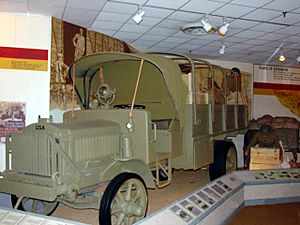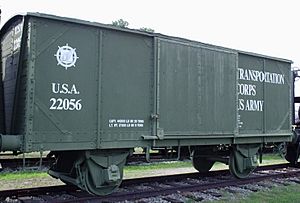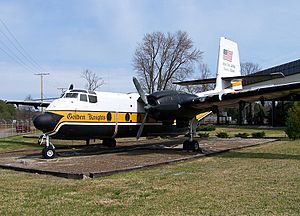U.S. Army Transportation Museum facts for kids
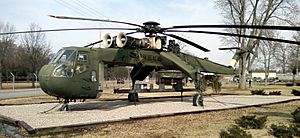
A Sikorsky CH-54 Tarhe helicopter, also known as a "Skycrane," outside the museum.
|
|
| Lua error in Module:Location_map at line 420: attempt to index field 'wikibase' (a nil value). | |
| Established | 1959 |
|---|---|
| Dissolved | 2025 |
| Location | Fort Eustis, Virginia |
| Type | Military Museum |
| Visitors | 50,000 |
The U.S. Army Transportation Museum was a museum in Virginia that showed the history of how the United States Army moves soldiers and supplies. It was filled with amazing vehicles and historical items. The museum was located at Fort Eustis, a U.S. Army base in Newport News.
The museum's collection featured everything from giant helicopters and airplanes to powerful trucks, boats, and even trains. It told the story of the U.S. Army Transportation Corps, the branch of the Army responsible for getting everything and everyone where they need to go.
Contents
History of the Museum
The museum first opened in 1959. It started in a simple warehouse with a small collection of items. These items were first gathered for an exhibit to help with Army recruiting.
As the collection grew, a new main building was opened in 1976. Later, in 1987, an outdoor area called an aviation pavilion was added to display large aircraft. The money to build these new spaces came from private donations collected by the Army Transportation Museum Foundation.
In 2021, some of the museum's large items, like a CH-54 "Skycrane" helicopter, were moved to another Army base called Fort Lee.
In June 2025, the Army closed the Transportation Museum at Fort Eustis. The museum's entire collection was relocated to the Quartermaster Museum at Fort Gregg-Adams. This was part of a plan to bring several Army history collections together in one place.
The Museum's Mission
The main goal of the museum was to teach visitors about the history of the United States Army Transportation Corps. It showed how important transportation is for the Army to succeed in its missions.
The museum was dedicated to General Frank S. Besson, Jr.. He was the first four-star general to be in charge of the Army's transportation command.
The museum's exhibits covered more than 200 years of history. They started with the American Revolutionary War and went all the way to modern operations in places like Afghanistan. The collection included nearly 100 full-size vehicles spread across 6 acres of land.
Amazing Exhibits and Vehicles
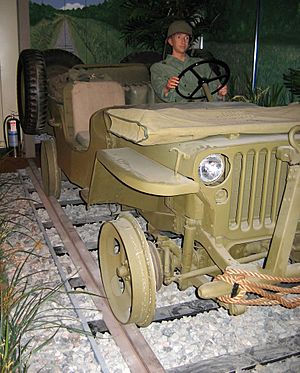
The museum had a large main building with 50,000 square feet (4,600 m2) of indoor exhibits. It also had four outdoor parks to display its biggest vehicles. Inside, visitors could walk through history and see displays, called dioramas, that showed transportation in different time periods.
Trucks and Land Vehicles
The museum showed how Army trucks developed over time. One popular exhibit was about the Liberty truck. This was the first truck that the Army standardized during World War I. This meant that parts from one truck could be used on another, making repairs much easier.
Another important exhibit was the Red Ball Express. This was a huge truck convoy system that supplied Allied forces in Europe after the D-Day invasion in World War II. The exhibit had photos and a diorama of a truck repair station, showing how soldiers kept the supplies moving.
The Vietnam War Era
The museum had a large section about the Vietnam War. It featured a famous gun truck named Eve of Destruction. Gun trucks were regular cargo trucks that soldiers covered with armor and machine guns to protect convoys. This is believed to be the only surviving gun truck from that time.
There was also a powerful diorama of a downed UH-1 "Huey" helicopter in a rice field. The exhibit also included bicycles that were used by the Viet Cong to move supplies.
Outdoor Parks
Outside the main building, visitors could explore several parks filled with incredible machines.
- The Vehicle Park had many types of military vehicles, including a DUKW, which was a truck that could drive on land and float like a boat.
- The Marine Park displayed Army boats, like tugboats and landing craft used to carry soldiers and equipment to shore.
- The Aviation Pavilion was home to many aircraft. It had helicopters like the OH-23 Raven and even a strange-looking flying machine called the HZ-1 Aerocycle. It also had a C-7 Caribou, a plane that could take off and land on very short runways.
- The Rail Exhibit showed the importance of trains to the Army. It had train cars used to transport soldiers in Berlin, Germany, after World War II, as well as cranes and other railroad equipment.


